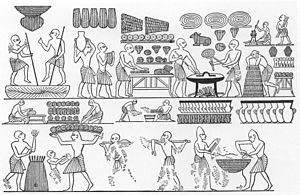The food of ancient Egypt covers a time span of more than three thousand years, but still retained many consistent traits until well into ...
The food of ancient Egypt covers a time span of more than three thousand years, but still retained many consistent traits until well into Greco-Roman times. The staples of both poor and rich Egyptians were bread and beer, often joined by green-shooted onions, different vegetables, and to a lesser extent meat, and fish.
Bread and Beer
 |
A depiction of the royal bakery from an engraving in
the tomb of Ramesses III in the Valley of the Kings.
|
Egyptian bread was made solely from emmer wheat, which was more hard to transform into flour than most other varieties of wheat. The chaff does not come-off through threshing, but rather comes in spikelets that should have been evacuated by moistening and pounding with a pestle to avoid from pulverizing the grains inside. It was then dried in the sun, winnowed and sieved lastly processed on a saddle quern, which worked by moving the grindstone forward and backward, instead of with a rotating movement. The preparing methods varied over the time. In the Old Kingdom, heavy pottery molds were filled with dough and then set in the embers to bake. At the Middle Kingdom tall cones were utilized on square hearths. In the New Kingdom another sort of a large open-topped clay oven, was utilized, which was encased in thick mud blocks and mortar. Batter was then slapped on the heated inner wall and peeled off when done, like how a tandoor stove is utilized for flat breads. Tombs from the New Kingdom show pictures of bread in a wide range of shapes and sizes. Loaves shaped like human figures, fish, different creatures and fans, all of shifting dough texture. Flavorings utilized for bread included coriander seeds and dates, yet it is not known whether this was ever utilized by poor people.
In Egypt beer was a primary source of nutrition, and consumed every day. Beer was such an imperative piece of the Egyptian diet that it was even utilized as currency. Like most modern African Beer, but not at all like European Beer, it was extremely cloudy with a lot of solids and profoundly nutritious, truly reminiscent of gruel. It was an important sources of protein, minerals and vitamins and was so valuable that beer jars were often used as a measurement of value and was used in medicine. Little is known as specific type of beer, yet there is notice of, for instance, sweet beer however with no particular points of interest said. Globular-based vessels with a narrow neck were utilized to store fermented beer from pre-dynastic times has been found at Hierakonpolis and Abydos with emmer wheat buildup that shows signs of gentle heating from below. Though not conclusive evidence of early beer brewing it is an indication that this might have been what they were used for. Archeological evidence shows that beer was made by first baking "beer bread", a type of well-leavened, lightly baked bread that did not kill the yeasts, which was then crumbled over a sieve, washed with water in a vat and then left to ferment. There are claims of dates or malts having been used, but the evidence is not concrete.








No comments